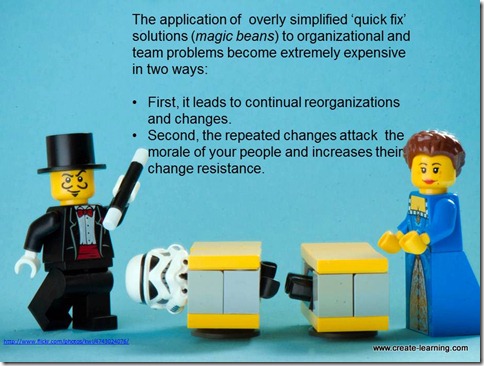
Executives, human resources and team leaders grasp at the ‘Next Thing’ in order to cut the down on the felt mounting bureaucracy and dis-trust within the organization and team. They do this while unknowingly increasing the skepticism, dis-engagement and change resistance of the employees.
Below are some examples that I have come across. Like a carnival barker asking desperate Executives, managers, organization development and human resources staff to
“Step right up and try this magical elixir that will cure all that ails ‘ya!”
False Quick fixes to organizational problems:
- New Age…the hierarchy will topple with this new e-generation
- Everyone acts “autonomously” doing what is right and everyone cooperates, without being clear of who is accountable or for what.
- The walk about and everything will work out
- Be like the Japanese
- Be excellent; go from good to great; all in under a minute; while looking for your cheese; on your iceberg.
- “We need more leaders and less managers”
The application of quick-fix solutions to organizational and team problems are proven costly in two ways
- they lead to continual reorganization and changes
- the repeated changes suck the morale right out of your people making them more change resistant.
What can be done?
Here is an effective way to start long term organizational success.
Determine and establish the necessary structure of managerial layering.
- Are there too many levels, too few, just enough levels within your organization.
- The guess-work of how many managerial layers to have causes dis-trust and halts any innovation within the organization.
Carry out a talent pool analysis of the employees starting with the CEO and working to the Front-Line Staff.
- How can you capture the capabilities of the people working if you have no idea just what they are capable of and they have no idea what is needed to successfully fill the role and do their best work?
- Once you determine how big the role and the goals plus time-span of the role. Succession planning, training & development all become clearer and tied to the business goals.
Ensure role filling, from top to bottom, with individuals with capability that matches each role.
- Putting the right people, with the ability to handle complexity, value the work, have the necessary skilled knowledge, contain the needed wisdom, and temperament to fill that role in those roles.
- Moving, de-selecting and possibly terminating people who are not able to be effective in that role, is tough; Especially when they were promoted for the wrong reasons.
Establish a compensation structure related to boundaries of the layer and level of work.
- Compensation that matches the felt ‘weight’ of the work shows respect and a system for compensation is understood.
- Similar work, that have similar time-spans and complexity are compensated similarly.
Conduct training to enable all managers to implement all requisite managerial leadership practices.
- If we are to make the organization function then certain things must be known and understood.
- One major area is that the Manager is to be held accountable for the work of the subordinates. For this to happen clear roles responsibilities, procedures, and accountabilities must be reinforced and equitable.

